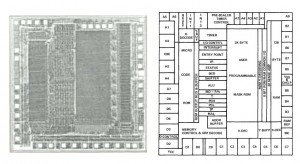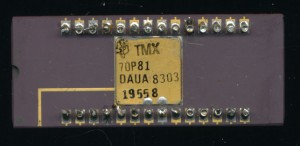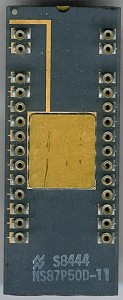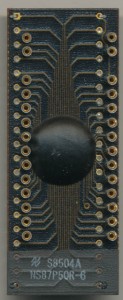TI TMS7000: The SCAT Microcontroller
The 1980’s brought many 8-bit microcontrollers to the market, such famous designs as the Intel MCS-51, the Zilog Z8, and the Motorola MC680x. There were many others as well, including TI’s entry into the market. After the race into the market with one of the first microcomputers, the 4-bit TMS1000, and the top of the line TMS9900 16-bit processor, TI saw the need to fill in the middle, the 8-bit market. TI didn’t want to make the 7000 series just another 8-bit MCU either, they wanted something different, not so different as to be eccentric, but something to set them apart. They did so with an innovation they called SCAT.

TMS7020 (2K EPROM + 128 bytes RAM) SCAT Layout. Notice the ‘strips’ that form the different sections of the MCU (click to enlarge)
SCAT, Strip Chip Architecture Topology, was TI’s die layout design for the TMS7000. Instead of generating each of the blocks for the chip (SLU, ROM, RAM, etc) making them as small as possible, and then using random logic to tie them all together, they laid them out in strips on the die. The ROM in a strip, the RAM in a strip, and the ALU etc in another. This allowed the sections to be wired up with a minimum of random logic, resulting in a smaller die, that was also easier to test. More importantly it allowed the TMS7000 to be easily expanded. Adding more ROM, or RAM didn’t require redoing the entire layout, it was just added to its respective ‘strip’.
Posted in:
CPU of the Day




